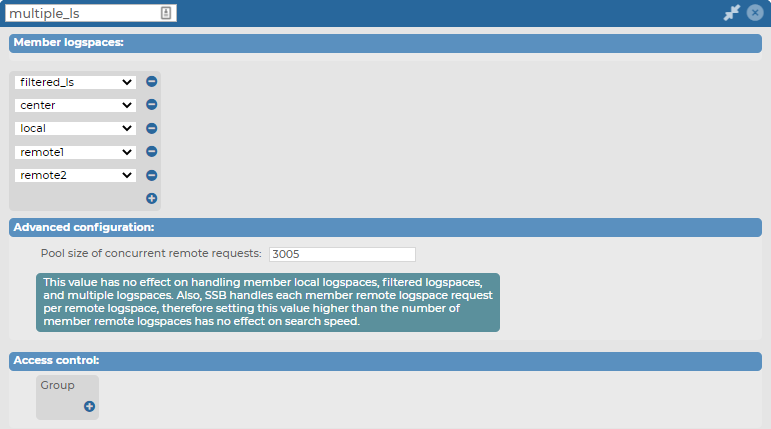If you have several syslog-ng Store Box (SSB) appliances located at different sites, you can view and search the logs of these machines from the same web interface without having to log on to several different interfaces.
Creating multiple logspaces can also be useful if you want to pre-filter log messages based on different aspects and then share these filtered logs only with certain user groups.
Multiple logspaces aggregate the messages that arrive from the member logspaces within the group. The new log messages are listed below each other every second.
Once configured, multiple logspaces can be searched like any other logspace on SSB. You can also create filtered logspaces that are based on the multiple logspaces.
NOTE: Multiple logspaces are only a view of the member logspaces. The log messages are still stored in the member logspaces (if the member logspace is a remote logspace, the log messages are stored on the remote SSB). As a result, you cannot alter any configuration parameters of the logspace directly. To do this, navigate to the member logspace itself.
NOTE: If a remote member logspace becomes inaccessible, you will not be able to view the contents of that logspace.
NOTE: Using multiple logspaces may decrease the performance of the appliance. If possible, manage your logspaces without using multiple logspaces (for example, instead of including several filtered logspaces into a multiple logspace, use several search expressions in a filtered logspace).
NOTE: If there are any multiple logspaces using your logspace as a member logspace, the multiple logspaces in question will be listed under Multiple logspaces using this as member. The list items are clickable links that will take you directly to the logspaces on the SSB web interface.
This list is only visible on the SSB web interface for Logspaces, Filtered Logspaces, Multiple Logspaces, and Remote Logspaces if they are member logspaces in any multiple logspaces.
Figure 148: Log > Multiple Logspaces — Creating multiple logspaces

To create multiple logspaces
-
Navigate to Log > Multiple Logspaces and click
.
-
Enter a name for the multiple logspace. Use descriptive names that help you to identify the source easily.
NOTE: When naming your multiple logspace, consider that the name of your multiple logspace must begin with either of the following:
-
a letter of the English alphabet
-
a number
-
an underscore (_)
-
a hyphen (-)
-
-
Select the Member logspaces from the list. To add a new member logspace, click
and select a different logspace.
NOTE: Consider the following:
-
You can only select logspaces that you previously configured as a local logspace / filtered logspace / remote logspace / multiple logspace.
-
You cannot add a multiple logspace to itself, only to a different multiple logspace. For example, you cannot add multiple_ls as a member of your multiple_ls multiple logspace.
-
You can add several of the same logspace types (that is, local / filtered / remote / multiple logspaces), but you cannot add the same unique logspace more than once.
-
-
Under Advanced configuration, set the pool size of the concurrent remote requests for the configured multiple logspaces. The default value is 2, and the minimum configurable value is 1.
NOTE: Consider the following:
-
Higher pool size settings may increase search speed in remote logspaces.
-
The Pool size of concurrent remote requests value is set per multiple logspace.
-
SSB only accesses remote logspaces parallelly. Parallel access is not effective for the following types of member logspaces:
-
filtered logspaces (even if the base of the filtered logspace is a remote logspace)
-
multiple logspaces
-
local logspaces
-
-
If more than one member remote logspace within the multiple logspace is located on the same remote SSB, then one of the following scenarios are possible:
-
The parallel or concurrent remote requests may result in performance issues on the remote SSB appliance.
-
Increasing the Pool size of concurrent remote requests value may affect search speed for remote logspaces located on the same remote host.
-
-
Increasing the Pool size of concurrent remote requests value will increase your network usage.
-
SSB handles each member remote logspace request per remote logspace, as a single element of the available pool. As a result, setting the Pool size of concurrent remote requests value to the same value as the number of member remote logspaces may increase your search speed, but setting it any higher will not increase your search speed further.
-
-
By default, members of the search group can view the stored messages online. Use the Access control option to control which usergroups can access the logspace. For details, see also Managing user rights and usergroups.
-
Click
.
